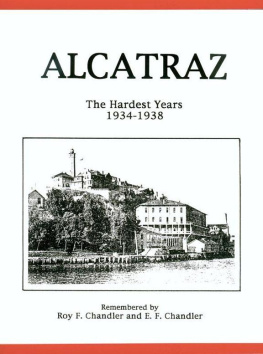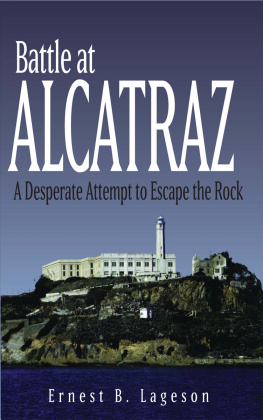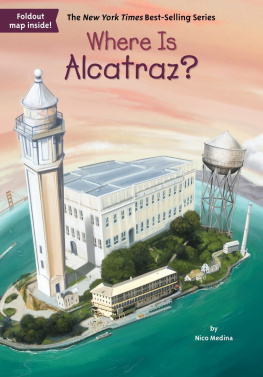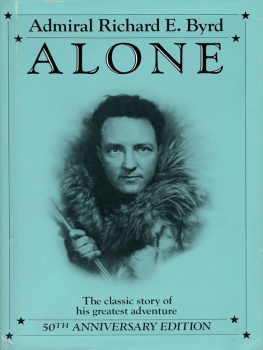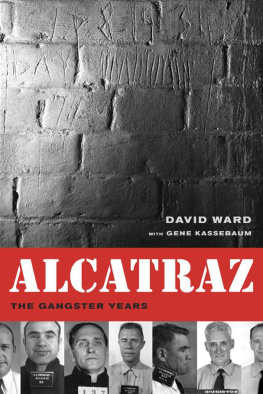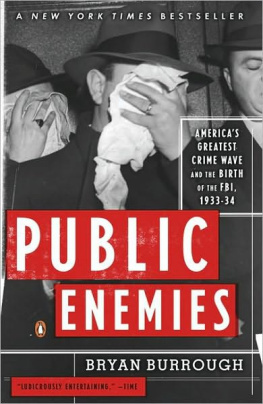Roy F. Chandler - Alcatraz: The Hardest Years 1934-1938
Here you can read online Roy F. Chandler - Alcatraz: The Hardest Years 1934-1938 full text of the book (entire story) in english for free. Download pdf and epub, get meaning, cover and reviews about this ebook. year: 1998, publisher: Iron Brigade Publishing, genre: Non-fiction. Description of the work, (preface) as well as reviews are available. Best literature library LitArk.com created for fans of good reading and offers a wide selection of genres:
Romance novel
Science fiction
Adventure
Detective
Science
History
Home and family
Prose
Art
Politics
Computer
Non-fiction
Religion
Business
Children
Humor
Choose a favorite category and find really read worthwhile books. Enjoy immersion in the world of imagination, feel the emotions of the characters or learn something new for yourself, make an fascinating discovery.
- Book:Alcatraz: The Hardest Years 1934-1938
- Author:
- Publisher:Iron Brigade Publishing
- Genre:
- Year:1998
- Rating:4 / 5
- Favourites:Add to favourites
- Your mark:
- 80
- 1
- 2
- 3
- 4
- 5
Alcatraz: The Hardest Years 1934-1938: summary, description and annotation
We offer to read an annotation, description, summary or preface (depends on what the author of the book "Alcatraz: The Hardest Years 1934-1938" wrote himself). If you haven't found the necessary information about the book — write in the comments, we will try to find it.
Alcatraz: The Hardest Years 1934-1938 — read online for free the complete book (whole text) full work
Below is the text of the book, divided by pages. System saving the place of the last page read, allows you to conveniently read the book "Alcatraz: The Hardest Years 1934-1938" online for free, without having to search again every time where you left off. Put a bookmark, and you can go to the page where you finished reading at any time.
Font size:
Interval:
Bookmark:
Copyright 1989 and 2013 Katherine R. Chandler
All rights reserved
Printing History
1989: First printing, Bacon & Freeman
1990: Second printing, Bacon & Freeman
1998: Third printing, Iron Brigade Armory
2008: Fourth printing, Iron Brigade Armory
ISBN-13: 9781885633132

Alcatraz Federal Penitentiary - Circa 1934
- Four small buildings comprising officers' and the warden's clerk's quarters
- Lighthouse keeper's home
- Warden's home
- Associate warden and various other illuminaries' homes
- Guards' quarters
- Single officers' quarters, guards' gym and recreation hall
- Old handball court. In 1937 a new wooden four-wall court was built on the parade ground almost beneath the cliff.
- The sand pile (for almost continual concrete repair).
The usual view of Alcatraz Island is a side shot taken from along the San Francisco waterfront. The unknown photographer who snapped this angle was within the off-limit buoys that once forced boats to keep their distance. If he was unauthorized, you can be sure that warning shots from a 30/06 Springfield rifle were plunked into the bay just off his bow.
A current visitor to Alcatraz will usually approach the island just as the boat from which this photo was taken did before 1934. A straight course from San Francisco brings a boat into the dock, which borders the right hand edge of the photograph.
Once ashore, a 1934/35 visitor clumped across a wide planked dock and gained clearance from a small guard shack placed tightly against the four story concrete building that looms in the forefront. In later Alcatraz years, the shack also housed a metal detector. That shack is still in use and comprises a part of the current visitors' tour.
An interested observer might note that the wind, as indicated by the smoke from the powerhouse and the flag flying from the warden's home, is blowing directly out the Golden Gate. Those concerned with escape attempts might then consider that if the tide ran with the wind a swimmer was quickly carried out the gate and into the Pacific Ocean. Or, if the tide was against the wind a fierce chop was set that was extremely difficult to swim across or against.
A barely visible pathway ran almost against the seawall just below the tree line in the forefront and continued around this end of the island. Custodial officers patrolled on the path because the island end was otherwise undefended and could not be observed by any of the gun towers. In a later photo officers Crabb and Crowell are shown further along this path. The large warning sign, unreadable on this page, is also shown more clearly.
Before he died in 1985, my father spent days with me hashing over the old Alcatraz. At eighty-one, Dad's mind was razor sharp on long past details, if not so good on what had happened last week.
He insisted on two points and spoke to them like this: "If you're going to write this stuff, get it right and don't add more crap to what is already out there." My father was not an admirer of the Alcatraz articles, books, and movies that have appeared over the decades.
He also said, "Write it simple and straight so people can enjoy the story. If you don't, it won't be worth reading."
So, that is how this book runs. It comes from an oral history and therefore is written in ordinary language and is conversationally organized. Our intention is that you gain a feel for what Alcatraz was likewhen it was new, special, and different from any other prison in America.
This small volume is not intended to be the ultimate Alcatraz tome. It focuses on the early years, the hardest years, as remembered by one guard, Erville Freeman Chandler, and his son, Roy Freeman Chandler.
This book is about Alcatraz before prisoners controlled their own cell lights, before they had radios, and before they talked as they wished. We write here of the prison's first four years, 1934-1938, when the big names and the hard guys were in residence.

E. F. Chandler saw 1934-1938 as the hardest years, in part, because the guards were as tough as the convicts. There was no slack in the system, and the prison had not lost its rough edges. Alcatraz did not reform or rehabilitateit confined and punished.
Alcatraz bit deeply into the minds of all who experienced those early years. It was a time of experimentdetermining just how best to run an Alcatraz. Dangerous, new to its participants, mysterious to all outsiders, and centered in the news media, Alcatraz prison grabbed attention. It was an adventurous period. Those involved, convict, guard or dependent, have never forgotten.
As the son and writer, I choose to record in a chatty style similar to my father's speech. This book is based primarily on our conversations about his years as an Alcatraz guard.
I omit most of his cuss words, although they were natural to him and would enrich the stories.
E. F. Chandler was a tough man. If he gave an inch I never saw or heard of it. You could like him or not, he really did not give a damn. But, you had better not cross him. My father's Golden Rule was: "Give better than you got." Prisoners regularly described him as "hard but fair."
I have extracted from my father's experience incidents and details we believe might better explain The Rock as it was during its most exacting period.
It would not be possible to document many of his anecdotes. They are drawn from one guard's memories. Also, our opinions are just thatopinions.
My father's sense of history is demonstrated by the amount of material he and my mother gathered while stationed on Alcatraz. They kept every newspaper article that appeared, even those from the east coast that friends and relatives forwarded. For years they purchased every Alcatraz book published. They also collected autographs, photographs, official Alcatraz forms, and made lists of all sortssome of which appear in this book. When facts and dates from my father's stories needed corroboration, we relied on the material that they had accumulated.

If you discover discrepancies with other records, remember: this is E. F. Chandler's account. His words and his opinion are about as first hand as any can be.
Remember also that no story can be repeated exactly the same even a second time. Repetitions polish tales until they may not be recognizable to the participants. I have worked at avoiding such pitfalls, and I am pleased with the result.
Our hope is that we offer fresh material, personal in nature and rich in character that can highlight a special periodAlcatraz in its hardest years.
It is necessary to emphasize that I, Roy F. Chandler, am the writer of this volume. The memories recorded and the opinions expressed are mine and my father'smostly my father's. We do not speak for the Bureau of Prisons, the Park Service, or others.
History is usually compiled at later dates by individuals not present during the events. The recorder believes he is correct, and his version, when published, often becomes accepted as factthe real story. A huge proportion of Alcatraz writing fits that description.
Therefore, it is especially important to record the memories and opinions of those who were actual participantsin this case, participants in Alcatraz's first four years as a federal prison. Of course, even witnesses to the same event can disagree, and the testimony of participant-witnesses often differs from accepted Alcatraz history. The more first-person points of view available, the greater the probability of gaining an accurate sense of how things actually occurred.
Next pageFont size:
Interval:
Bookmark:
Similar books «Alcatraz: The Hardest Years 1934-1938»
Look at similar books to Alcatraz: The Hardest Years 1934-1938. We have selected literature similar in name and meaning in the hope of providing readers with more options to find new, interesting, not yet read works.
Discussion, reviews of the book Alcatraz: The Hardest Years 1934-1938 and just readers' own opinions. Leave your comments, write what you think about the work, its meaning or the main characters. Specify what exactly you liked and what you didn't like, and why you think so.

